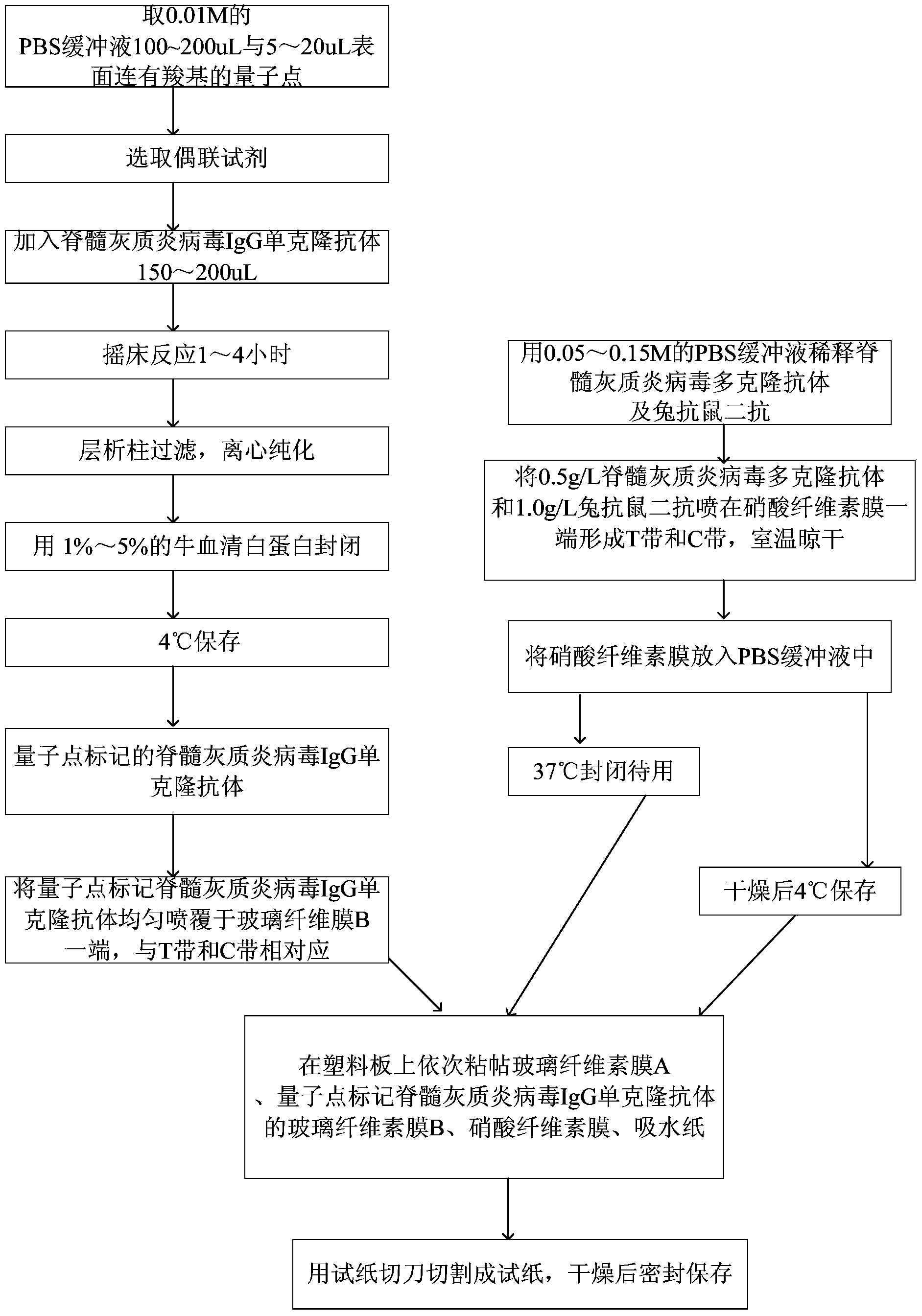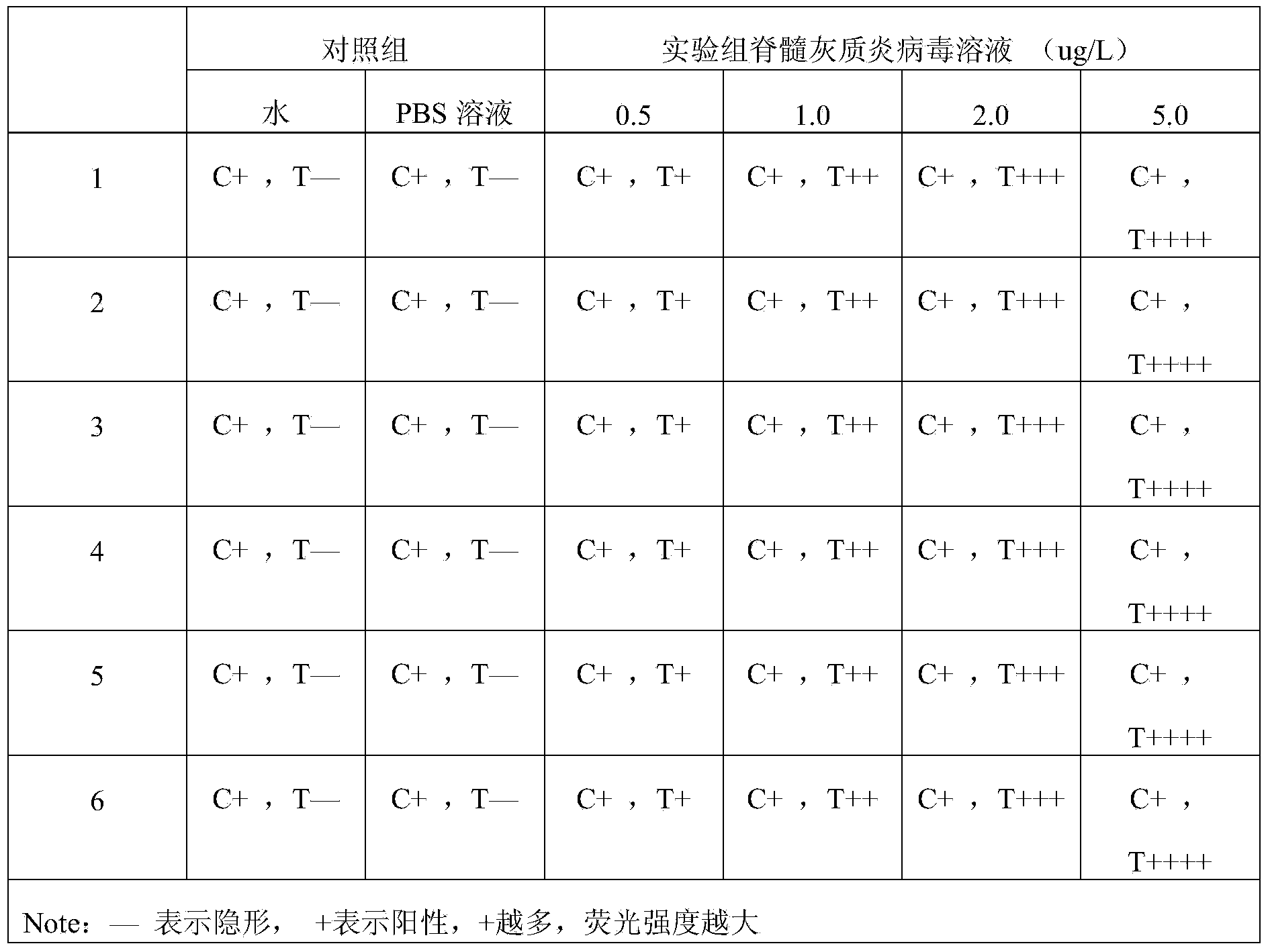Method for detecting poliovirus, quantum dot-labeled immunochromatographic test paper and preparation method thereof
An immunochromatographic test paper and polio technology, which is applied in the field of medical immunological detection, can solve the problems of low accuracy and low sensitivity, and achieve the effect of narrow emission peak, good luminescence stability, and symmetrical peak shape
- Summary
- Abstract
- Description
- Claims
- Application Information
AI Technical Summary
Problems solved by technology
Method used
Image
Examples
Embodiment 1
[0032] Example 1: A quantum dot-labeled immunochromatographic test paper, comprising a plastic plate, a nitrocellulose membrane, a glass cellulose membrane A, a quantum dot-labeled glass cellulose membrane B for poliovirus IgG monoclonal antibody, and absorbent paper , the glass cellulose film A is a commercially available glass cellulose film without spotting;
[0033] Wherein, glass cellulose membrane A, glass cellulose membrane B marked with poliovirus IgG monoclonal antibody by quantum dots, nitrocellulose membrane and absorbent paper are pasted on the plastic plate in sequence;
[0034] Wherein, one end of the nitrocellulose membrane has a poliovirus polyclonal antibody and a rabbit anti-mouse secondary antibody to form a detection zone T and a quality control zone C;
[0035] Wherein, the quantum dot-labeled poliovirus IgG monoclonal antibody is located at the other end of the glass cellulose membrane B, corresponding to the detection zone T and the quality control zone ...
Embodiment 2
[0041] Embodiment 2: the preparation method of the test paper as above, as figure 1 shown, including the following steps:
[0042] (1) Conjugation of quantum dots with poliovirus IgG monoclonal antibody:
[0043] Take 100-200uL of 0.01M PBS buffer and 5-20uL of quantum dots with carboxyl groups attached to the surface;
[0044] Select a coupling reagent, and the coupling reagent is selected from hydroxythiosuccinimide, 1-(3-dimethylaminopropyl)-3ethylcarbodiamine hydrochloride;
[0045] Add 150-200uL of poliovirus IgG monoclonal antibody;
[0046] Shaker reaction for 1 to 4 hours;
[0047] Chromatography column filtration, centrifugal purification;
[0048] Block with 1% to 5% bovine serum albumin;
[0049] Store at 4°C;
[0050] (2) Preparation of test paper:
[0051] Dilute poliovirus polyclonal antibody and rabbit anti-mouse secondary antibody with 0.05-0.15M PBS buffer, spray 0.5g / L poliovirus polyclonal antibody and 1.0g / L rabbit anti-mouse secondary antibody on ni...
Embodiment 3
[0058] Example 3: Detecting poliovirus with the test paper, including the following steps: spotting the sample on the assembled test paper close to one end of the poliovirus IgG monoclonal antibody, reacting for 5 minutes, and placing the sample in an ultraviolet analyzer. Observation results. PBS buffer and normal human blood were used as blank controls.
[0059] Judgment of the results: On the premise that the C band shows a red fluorescent band, the intensity of the fluorescence band of the T band is visually observed. Compared with the blank control, the weaker the fluorescence, the lower the concentration of the tested substance in the solution to be tested.
PUM
| Property | Measurement | Unit |
|---|---|---|
| concentration | aaaaa | aaaaa |
| diameter | aaaaa | aaaaa |
Abstract
Description
Claims
Application Information
 Login to View More
Login to View More - R&D
- Intellectual Property
- Life Sciences
- Materials
- Tech Scout
- Unparalleled Data Quality
- Higher Quality Content
- 60% Fewer Hallucinations
Browse by: Latest US Patents, China's latest patents, Technical Efficacy Thesaurus, Application Domain, Technology Topic, Popular Technical Reports.
© 2025 PatSnap. All rights reserved.Legal|Privacy policy|Modern Slavery Act Transparency Statement|Sitemap|About US| Contact US: help@patsnap.com


